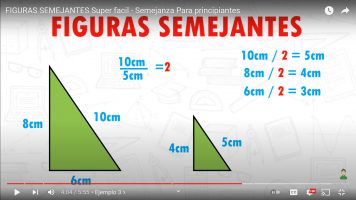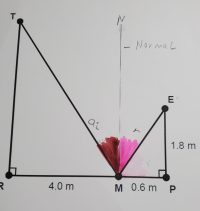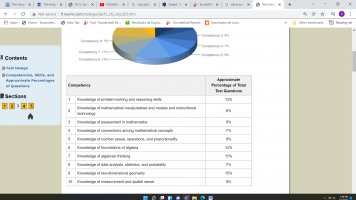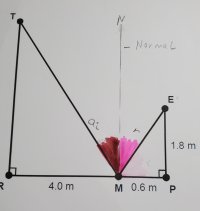Complements. Did you notice that word used repeatedly in the video?what does c stand for?
You are using an out of date browser. It may not display this or other websites correctly.
You should upgrade or use an alternative browser.
You should upgrade or use an alternative browser.
The height TR of a tree
- Thread starter eddy2017
- Start date
eddy2017
Elite Member
- Joined
- Oct 27, 2017
- Messages
- 2,525
yes, I did notice. the angles formed by the normal are complementary, that is, the sum of these equals 90 degrees, and the normal always forms a right angle with the surface. Yes, I saw it at right at the start,OK. You have the normal. Put an end point N on it (for normal) so you can describe the angles that you are talking about.
Now you are TECHNICALLY wrong as to the angle of incidence and as to the angle of reflection, but the shaded angles are indeed the ones that you are ULTIMATELY interested in mathematically.
What you have labeled [imath]a_i[/imath] and [imath]a_r[/imath] are of importance even though they are not the angles of incidence and reflection. I suggest that go
[math]c_i \text { is the measure of } \angle \text { TMR, and }\\ c_r \text { is the measure of } \angle \text {EMP .}[/math]
Now what are the angle of incidence and the angle of reflection?
I looked at the video. It is good. I agree. But it is focused on a harder problem than this one.
Nevertheless, it gets at my point. The angles that you are talking about are complements of the angles of incidence and reflection. Did you notice that early in the video?
Did you follow my advice and label the normal line MN?
The angles of incidence and reflection are made with respect to the normal line, which I have suggested you call MN.
In other words, angle TMN is the angle of incidence, and angle EMN is the angle of reflection, right? Is that not what your video shows?
Those two angles are equal. But we are not ultimately interested in those angles. We are interested in the angles inside the triangles TMR and PME.
What are the MATHEMATICAL facts used to get from the angles of incidence and reflection to angles inside the triangles?
The angles of incidence and reflection are made with respect to the normal line, which I have suggested you call MN.
In other words, angle TMN is the angle of incidence, and angle EMN is the angle of reflection, right? Is that not what your video shows?
Those two angles are equal. But we are not ultimately interested in those angles. We are interested in the angles inside the triangles TMR and PME.
What are the MATHEMATICAL facts used to get from the angles of incidence and reflection to angles inside the triangles?
Yes. Being very persnickety, you really should have said [imath]a_r[/imath] in your diagram to maintain a consistent notation,but that is not an error.
Now the physical fact that is relevant to this problem is [math]a_i = a_r.[/math]
Then there are a number of geometric facts you need to know.
Again you need labels.
[math]\text {The measures of }\\ \angle \text { NMR} = b,\\ \angle \text { NMP} = d,\\ \angle \text { TMR} = c_i,\\ \angle \text { EMP} = c_r,\\ \angle \text { MRT} = e, \\ \angle \text { MPE} = p,\\ \angle \text { RTM} = q, \text { and }\\ \angle \text { PEM} = s.[/math]
Now you cannot directly find the numerical value of all these angles, but you can find algebraic relations among them.
If you can prove that the measures of the angles in one triangle equal the measures of angles in another triangle, then the triangles are similar. Can you do that?
Now the physical fact that is relevant to this problem is [math]a_i = a_r.[/math]
Then there are a number of geometric facts you need to know.
Again you need labels.
[math]\text {The measures of }\\ \angle \text { NMR} = b,\\ \angle \text { NMP} = d,\\ \angle \text { TMR} = c_i,\\ \angle \text { EMP} = c_r,\\ \angle \text { MRT} = e, \\ \angle \text { MPE} = p,\\ \angle \text { RTM} = q, \text { and }\\ \angle \text { PEM} = s.[/math]
Now you cannot directly find the numerical value of all these angles, but you can find algebraic relations among them.
If you can prove that the measures of the angles in one triangle equal the measures of angles in another triangle, then the triangles are similar. Can you do that?
eddy2017
Elite Member
- Joined
- Oct 27, 2017
- Messages
- 2,525
I have kept studying to try and see if i can make some inroads into this here problem with your guidance, of course. Thank you Jeff and Dr Khan for being patient and letting me do my research. I may have not much, but I have watched a some videos about similarities of triangles and law of reflection and gotten some ideas about that. This is uncharted territory for me, as you well know, because you are my tutors. So, I thought, maybe this is a case of someone biting more than he can really chew but I am gonna keep on chewing this bite!
What do I have now than did not have before?.
Well, besides learning a little bit about what the angle of incidence and the angle of reflection is and how they're formed. I have also watched basic tutorials about the similarities of triangles. Geometric figures can differ in size but even so, their sides can be proportional and their angles can have the same measure.
How can i relate al this our problem?
Well, I see that the two triangles given form a right angle, a right angle measures 90 degrees.
I can see now that some the things learned may apply here :
That angle MRT and angle MPE have different size, but their sides are proportional though
Side TR = ?, but side EP is proportional to it and i have its length TP=1.8M
So, here's Dr Khan famous saying comes ' what is the FIND'
This is it: Given the measurements shown in the diagram what is the length of TR?
I have learned that when dealing with similar angles where they Find is to find the length of one its sides, I have to look at the GIVEN measures and try to look for a factor or ratio and that I cant achieve that by dividing similar sides. then I should look for similar sides with values and divide them to find that ratio and apply to find the unknown side.
something like this

but I am confused on how to take this info and apply (if it can be applied to the problem at hand).
I see that according to the law of similarities of triangles TP has to be proportional to EP and EP=1.8
but this problem is different that the one I posted here( at the end they give you practice) it is different in that I have the measurements of the two bases of the triangle. I have EP as 1.8
I am failing to see how to find a ratio here to use to solve for the length of TP
Thank you for any tip, and for giving the time to do my own research and at least come up with something, that in the end might be a whole lot of nothing!.
Thanks for any tip as always
What do I have now than did not have before?.
Well, besides learning a little bit about what the angle of incidence and the angle of reflection is and how they're formed. I have also watched basic tutorials about the similarities of triangles. Geometric figures can differ in size but even so, their sides can be proportional and their angles can have the same measure.
How can i relate al this our problem?
Well, I see that the two triangles given form a right angle, a right angle measures 90 degrees.
I can see now that some the things learned may apply here :
That angle MRT and angle MPE have different size, but their sides are proportional though
Side TR = ?, but side EP is proportional to it and i have its length TP=1.8M
So, here's Dr Khan famous saying comes ' what is the FIND'
This is it: Given the measurements shown in the diagram what is the length of TR?
I have learned that when dealing with similar angles where they Find is to find the length of one its sides, I have to look at the GIVEN measures and try to look for a factor or ratio and that I cant achieve that by dividing similar sides. then I should look for similar sides with values and divide them to find that ratio and apply to find the unknown side.
something like this

but I am confused on how to take this info and apply (if it can be applied to the problem at hand).
I see that according to the law of similarities of triangles TP has to be proportional to EP and EP=1.8
but this problem is different that the one I posted here( at the end they give you practice) it is different in that I have the measurements of the two bases of the triangle. I have EP as 1.8
I am failing to see how to find a ratio here to use to solve for the length of TP
Thank you for any tip, and for giving the time to do my own research and at least come up with something, that in the end might be a whole lot of nothing!.
Thanks for any tip as always
Last edited:
BigBeachBanana
Senior Member
- Joined
- Nov 19, 2021
- Messages
- 2,181
You're correct that TR is proportional to EP. Which other side are proportional? if you reflect the smaller triangle over the Normal line. You'll have 2 similar triangles as in the video.
eddy2017
Elite Member
- Joined
- Oct 27, 2017
- Messages
- 2,525
Hey, thanks, BBB.You're correct that TR is proportional to EP. Which other side are proportional? if you reflect the smaller triangle over the Normal line. You'll have 2 similar triangles as in the video.
I see that TM and ME are proportional too.
the bases I think, are proportional but as they have different measures, don't know how to explain that.
Last edited:
BigBeachBanana
Senior Member
- Joined
- Nov 19, 2021
- Messages
- 2,181
You're correct, but we were given the lengths of the bases so let's use that.see that TM and ME are proportional too.
Be careful with the language [math].6 \neq .4[/math]Ok, so you know that the bases are proportional and TR & EP are proportional. What is it mean to be proportional?0.6 is equivalent to 0.4.
D
Deleted member 4993
Guest
Your OP:I have kept studying to try and see if i can make some inroads into this here problem with your guidance, of course. Thank you Jeff and Dr Khan for being patient and letting me do my research. I may have not much, but I have watched a some videos about similarities of triangles and law of reflection and gotten some ideas about that. This is uncharted territory for me, as you well know, because you are my tutors. So, I thought, maybe this is a case of someone biting more than he can really chew but I am gonna keep on chewing this bite!
What do I have now than did not have before?.
Well, besides learning a little bit about what the angle of incidence and the angle of reflection is and how they're formed. I have also watched basic tutorials about the similarities of triangles. Geometric figures can differ in size but even so, their sides can be proportional and their angles can have the same measure.
How can i relate al this our problem?
Well, I see that the two triangles given form a right angle, a right angle measures 90 degrees.
I can see now that some the things learned may apply here :
That angle MRT and angle MPE have different size, but their sides are proportional though
Side TR = ?, but side EP is proportional to it and i have its length TP=1.8M
So, here's Dr Khan famous saying comes ' what is the FIND'
This is it: Given the measurements shown in the diagram what is the length of TR?
I have learned that when dealing with similar angles where they Find is to find the length of one its sides, I have to look at the GIVEN measures and try to look for a factor or ratio and that I cant achieve that by dividing similar sides. then I should look for similar sides with values and divide them to find that ratio and apply to find the unknown side.
something like this
View attachment 30528
but I am confused on how to take this info and apply (if it can be applied to the problem at hand).
I see that according to the law of similarities of triangles TP has to be proportional to EP and EP=1.8
but this problem is different that the one I posted here( at the end they give you practice) it is different in that I have the measurements of the two bases of the triangle. I have EP as 1.8
I am failing to see how to find a ratio here to use to solve for the length of TP
Thank you for any tip, and for giving the time to do my own research and at least come up with something, that in the end might be a whole lot of nothing!.
Thanks for any tip as always

In this problem triangle TRM is similar to EPM.
Using laws of similar triangles:
TR/EP = RM/PM ............................................proportional sides
TR = RM/ PM * EP = 4/ 0,6 * 1.8 = 12 m
Eddy, in my opinion, one thing is holding you back - and that is you are not following a standard textbook or curriculum. Those suggest a sequence of topics to tackle. That sequence "solidifies" foundation. As you know, without solid foundation, buildings fall down.
eddy2017
Elite Member
- Joined
- Oct 27, 2017
- Messages
- 2,525
that they have the same ratio,that when the sides are corresponding you can go from one triangle to another by multiplying each side by the same number.You're correct, but we were given the lengths of the bases so let's use that.
Be careful with the language [math].6 \neq .4[/math]Ok, so you know that the bases are proportional and TR & EP are proportional. What is it mean to be proportional?
BigBeachBanana
Senior Member
- Joined
- Nov 19, 2021
- Messages
- 2,181
Right, so let's call this ratio x. Since RM and PM are proportional, then [imath]\frac{RM}{PM}=x[/imath]. Once you found x, we also know that TR is proportional to EP, so the ratio must also be equal to x: [imath]\frac{TR}{EP}=x[/imath]that they have the same ratio,that when the sides are corresponding you can go from one triangle to another by multiplying each side by the same number.
Now can you substitute in the corresponding values and find TR?
eddy2017
Elite Member
- Joined
- Oct 27, 2017
- Messages
- 2,525
I have the math skills I have to conquer to pass the test. I am working the skills as best as I can. I dont have a math teacher and i am not a regular day r evening student. I have to go by these skills. i have to master them to take the test.I'm posting them for you hereYour OP:
View attachment 30529
In this problem triangle TRM is similar to EPM.
Using laws of similar triangles:
TR/EP = RM/PM ............................................proportional sides
TR = RM/ PM * EP = 4/ 0,6 * 1.8 = 12 m
Eddy, in my opinion, one thing is holding you back - and that is you are not following a standard textbook or curriculum. Those suggest a sequence of topics to tackle. That sequence "solidifies" foundation. As you know, without solid foundation, buildings fall down.

I have to master all these thru exercises and practice on my own. No easy task , but i have to give this a try. I have nothing to lose but some math ignorance. Right now I can't afford a tutor because the price for an hour is more than i can afford so i am taking this goliath on my own and thanking you for any help. You send me links I will study them and then drop me hints. I am taking more time now to answer because I am working and studying. all my spare time is devoted to this. all!, no tv, no beach, no social outings nothing.
Last edited:
eddy2017
Elite Member
- Joined
- Oct 27, 2017
- Messages
- 2,525
After Dr Khan explanation then it iis easy, but is kind of another way of thinking about it and getting the same result.Right, so let's call this ratio x. Since RM and PM are proportional, then [imath]\frac{RM}{PM}=x[/imath]. Once you found x, we also know that TR is proportional to EP, so the ratio must also be equal to x: [imath]\frac{TR}{EP}=x[/imath]
Now can you substitute in the corresponding values and find TR?
ratio x= RM/PM =4/0.6=6.66666666667
So,
ratio X of TR/EP = x/1.8
6.66666666667= x/1.8
x= 6.66666666667 * 1.8
=12 m
the length of TR is 12 m
Eddy
I sympathize with your dilemma, but the Khan is correct.
To solve this problem, you need to know one fact of physics (which is not part of mathematics at all), and both some basic plane geometry and some basic algebra. It is too much to absorb in one go. I suggest you buy a book with exercises on elementary algebra and fully master that before trying geometry. Someone here can undoubtedly suggest a good textbook that will take you from step 1 of algebra up to or even into pre-calculus. It is hard to learn math from a textbook alone, but they are far less expensive than a tutor, and we here could be more help if you were following a systematic course of study, even one that some of us think may be less than ideal.
I sympathize with your dilemma, but the Khan is correct.
To solve this problem, you need to know one fact of physics (which is not part of mathematics at all), and both some basic plane geometry and some basic algebra. It is too much to absorb in one go. I suggest you buy a book with exercises on elementary algebra and fully master that before trying geometry. Someone here can undoubtedly suggest a good textbook that will take you from step 1 of algebra up to or even into pre-calculus. It is hard to learn math from a textbook alone, but they are far less expensive than a tutor, and we here could be more help if you were following a systematic course of study, even one that some of us think may be less than ideal.
eddy2017
Elite Member
- Joined
- Oct 27, 2017
- Messages
- 2,525
Thank you both. the good thing about this is that I classify all the problems and exercises digitally. I have folders classified by name of the problem and type of exercise. I am creating my own archive . If I deal with another exercise like this at least I have all these explanations and approaches to check and set against the the problem I'm taking. If you see that i am taking time to answer something is because i am researching. there is a ton of information out there. I appreciate when you send links or topics to research because that is really a time-saver for me.
thanks a lot!
thanks a lot!

